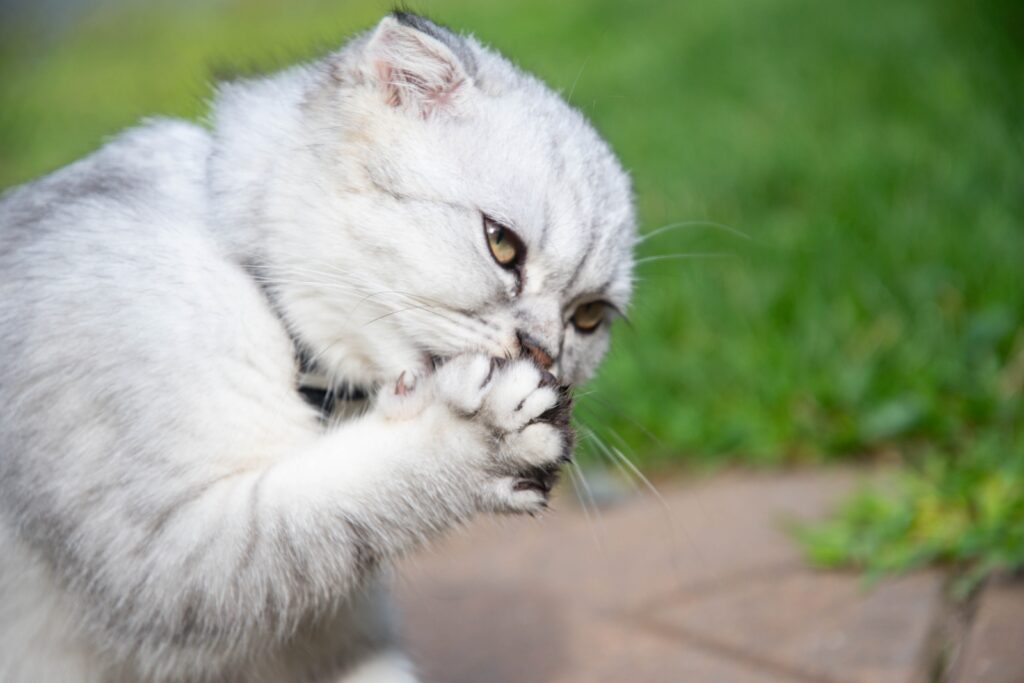How Do I Get My Cat To Stop Scratching Me

Get My Cat To Stop Scratching Me: Cats are lovely companions, but their sharp claws can sometimes be a problem, especially when they start scratching their owners. Understanding the reasons behind this behavior and learning effective strategies to address it are crucial for maintaining a harmonious relationship with your feline friend. In this blog post, we’ll explore how to get your cat to stop scratching you by examining the root causes and providing practical solutions for a scratch-free household. Don’t worry, with a little patience and consistency, your cat will soon be on its way to better, less destructive habits.
Understanding Why Cats Scratch
If you’re a cat owner, you’ve probably experienced the pain of a scratch or two from your furry friend. It’s important to understand why cats scratch so that you can provide them with appropriate alternatives and prevent them from scratching you or your furniture. Here are three reasons why cats scratch:
Instinctual Behavior
Scratching is a natural behavior for cats. They do it to stretch their muscles, sharpen their claws, and relieve stress. In the wild, cats scratch trees and other surfaces to mark their territory and leave visual and scent markings for other cats. Indoor cats do not have access to trees, so they may scratch furniture or walls instead.
Communication
Cats also use scratching as a way to communicate with other cats and humans. They leave visual and scent markings to show ownership of the territory and to signal their presence. They may scratch near doorways or windows to mark the entrance and exit points of their territory. When cats scratch humans, it may be a sign of affection or a way to get attention.
Territory Marking
Cats have scent glands in their paws, and scratching leaves behind a scent that other cats can detect. By scratching, cats can mark their territory and communicate with other cats. If you have multiple cats, it’s important to provide each cat with its own scratching post or tree to prevent territorial disputes.
Understanding why cats scratch is the first step in preventing unwanted scratching behavior. By providing your cat with appropriate scratching surfaces and understanding their communication cues, you can create a happy and harmonious home for both you and your feline friend.
——————————-
Get access to the best pet discounts, items, and training by clicking the link below
————————————-
Providing Appropriate Scratching Surfaces
Scratching is a natural behavior for cats, and it’s important to provide them with appropriate surfaces to satisfy this urge. Here are some tips and tricks for providing your cat with the best scratching surfaces.
Types of Scratching Surfaces
Cats have different preferences when it comes to scratching surfaces, so it’s important to offer a variety of options. Some popular options include:
- Vertical scratching posts
- Horizontal scratchers
- Cardboard scratchers
- Sisal rope scratchers
Placement and Accessibility
It’s important to place the scratching surface in an area where your cat spends a lot of time. Cats like to scratch after waking up from a nap or after eating, so placing the scratching surface near their bed or food bowl is a good idea.
Accessibility is also important. If your cat has to climb over furniture to get to the scratching surface, it may be less likely to use it. Make sure the scratching surface is easily accessible and visible.
When introducing a new scratching surface, it’s important to make it appealing to your cat. You can do this by placing catnip on the scratching surface or rubbing it with a little bit of tuna juice.
Providing appropriate scratching surfaces is an important part of cat ownership. By offering a variety of surfaces and placing them in accessible areas, you can help prevent your cat from scratching you or your furniture.
Distracting Your Cat from Scratching You
Cats are adorable, cuddly, and great companions. However, they can also be a bit rough when it comes to playtime, resulting in scratches and bites. Scratching is a natural behavior for cats, but it can be painful for humans. Fortunately, there are a few ways to distract your cat from scratching you. Here are some tips to help you out.
Interactive Playtime
One of the best ways to distract your cat from scratching you is by engaging them in interactive playtime. This could include playing fetch, using a laser pointer, or dangling a toy for them to chase. Interactive playtime not only distracts your cat from scratching you but also provides exercise and mental stimulation.
Toys
Another way to distract your cat from scratching you is by providing them with toys. Cats love toys, and there are a variety of toys available that can keep them engaged and entertained. Some of the best toys for cats include scratching posts, puzzle toys, and catnip toys. These toys provide a healthy outlet for your cat’s natural instincts and can help prevent them from scratching you.
Treats
Treats are another effective way to distract your cat from scratching you. Cats love treats, and you can use them to reward good behavior and distract them from scratching. Treats can also be used as a training tool to teach your cat not to scratch you. However, it is important to remember that treats should be given in moderation to prevent your cat from becoming overweight.
——————————-
Get access to the best pet discounts, items, and training by clicking the link below
————————————-
Discouraging Bad Scratching Habits
As much as we love our cats, their scratching habits can be quite frustrating and painful. However, it is essential to remember that scratching is a natural behavior for cats. It helps them groom their claws, mark their territory, and stretch their muscles. Therefore, instead of punishing your cat for scratching, it is best to redirect its behavior to a more appropriate place. Here are two effective techniques to discourage bad scratching habits:
Positive Reinforcement
Positive reinforcement involves rewarding your cat for good behavior. In this case, you can reward your cat whenever they scratch a scratching post or pad instead of your furniture or skin. The reward can be anything your cat finds rewarding, such as treats, petting, or playtime. Here’s how to use positive reinforcement to discourage bad scratching habits:
1. Place a scratching post or pad near the areas your cat tends to scratch.
2. Encourage your cat to use the scratching post or pad by placing treats or catnip on or around it.
3. When your cat uses the scratching post or pad, reward them with treats, petting, or playtime.
4. Repeat this process consistently until your cat starts using the scratching post or pad without any rewards.
Negative Reinforcement
Negative reinforcement involves discouraging your cat from bad behavior by adding an unpleasant consequence. In this case, you can use a harmless deterrent to discourage your cat from scratching your furniture or skin. Here’s how to use negative reinforcement to discourage bad scratching habits:
1. Choose a harmless deterrent that your cat dislikes, such as double-sided tape, aluminum foil, or citrus spray.
2. Apply the deterrent on the areas your cat tends to scratch, such as your sofa or curtains.
3. When your cat tries to scratch the deterrent, it will dislike the sensation and stop scratching.
4. Repeat this process consistently until your cat stops scratching the deterrent areas.
Seeking Professional Help
If your cat’s scratching behavior is causing harm and you have tried all the methods discussed earlier, it might be time to seek professional help. Here are two types of professionals who can help you deal with your cat’s scratching behavior:
Consulting with a Vet
The first professional you should consider consulting with is a veterinarian. Scratching can be a natural feline behavior, but it can also be a sign of a medical issue. Your vet can examine your cat and rule out any underlying medical condition that may be causing the scratching behavior. If your cat is suffering from an illness or an injury, your vet can provide the necessary treatment.
Additionally, your vet can recommend and prescribe medications that can help calm your cat’s scratching behavior. These medications may include pheromone sprays, anti-anxiety medication, or even painkillers.
Consulting with a Cat Behaviorist
If your vet rules out any medical condition, it is time to consult with a cat behaviorist. A behaviorist can help identify the root cause of your cat’s scratching behavior and provide targeted solutions to mitigate it.
The behaviorist will first observe your cat and assess their environment before making any recommendations. They may recommend changes to your cat’s living space, such as providing more scratching posts or creating more hiding spots. They may also recommend environmental enrichment activities to keep your cat mentally stimulated and reduce their stress levels.
Moreover, the behaviorist can help you train your cat to use the scratching post instead of scratching people or furniture. They can also teach you how to use positive reinforcement training to reward good behavior and discourage negative behavior.
——————————-
Get access to the best pet discounts, items, and training by clicking the link below
————————————-
Conclusion
In conclusion, getting your cat to stop scratching you requires patience and consistency. It is important to understand that scratching is a natural behavior for cats, and it serves several purposes, including stretching and marking territory. Providing your cat with appropriate scratching surfaces, such as scratching posts or pads, can redirect their behavior and save your furniture and skin.
Additionally, positive reinforcement can go a long way in changing your cat’s behavior. Reward your cat when they use their scratching post or pad, and discourage them from scratching you by redirecting their attention or using a firm “no” command. It is vital to avoid physical punishment as it can cause fear and aggression in your feline friend.
Finally, if you have tried all these tips and your cat continues to scratch you, consider seeking advice from a veterinarian or animal behaviorist. With proper guidance and patience, you can teach your cat to scratch appropriate surfaces and enjoy a peaceful and scratch-free coexistence.
Get My Cat To Stop Scratching Me FAQ:
Why does my cat scratch me?
Cats are natural scratchers and they use their claws to mark their territory. It is also a way for them to stretch and exercise their muscles. However, sometimes cats scratch their owners because they are overstimulated, anxious, or feeling playful. It is important to understand why your cat is scratching you so that you can address the issue effectively.
How can I train my cat to stop scratching me?
Training your cat to stop scratching can take some time and patience, but it is definitely possible. One way to do this is to redirect their attention to a scratching post or pad. Whenever you see your cat starting to scratch you, gently pick them up and place them next to the post or pad and encourage them to scratch it. You can also try using a deterrent spray on the areas that your cat likes to scratch. Another important thing to remember is to never punish your cat for scratching you, as this can cause fear and anxiety.
What kind of scratching post or pad should I get for my cat?
When choosing a scratching post or pad for your cat, it is important to consider their preferences. Some cats prefer vertical scratching posts, while others prefer horizontal pads. The material of the post or pad is also important – some cats prefer carpet, while others like sisal or cardboard. It is a good idea to experiment with different types of posts and pads to see what your cat likes best.
What if my cat continues to scratch me despite my efforts?
If your cat continues to scratch you despite your efforts to redirect their attention, it may be a good idea to consult with a veterinarian or a cat behaviorist. They can help you identify the underlying cause of your cat’s behavior and develop a plan to address it effectively.








